
Agate is a variety of chalcedony, which comes in a wide variety of colors. Agates are primarily formed within volcanic and metamorphic rocks. The ornamental use of agate was common in ancient Greece, in assorted jewelry and in the seal stones of Greek warriors, while bead necklaces with pierced and polished agate date back to the 3rd millennium BCE in the Indus Valley civilisation.

Granite is a coarse-grained (phaneritic) intrusive igneous rock composed mostly of quartz, alkali feldspar, and plagioclase. It forms from magma with a high content of silica and alkali metal oxides that slowly cools and solidifies underground. It is common in the continental crust of Earth, where it is found in igneous intrusions. These range in size from dikes only a few centimeters across to batholiths exposed over hundreds of square kilometers.
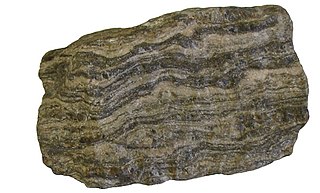
Gneiss is a common and widely distributed type of metamorphic rock. It is formed by high-temperature and high-pressure metamorphic processes acting on formations composed of igneous or sedimentary rocks. This rock is formed under pressures ranging from 2 to 15 kbar, sometimes even more, and temperatures over 300 °C (572 °F). Gneiss nearly always shows a banded texture characterized by alternating darker and lighter colored bands and without a distinct cleavage.

Marble is a metamorphic rock consisting of carbonate minerals (most commonly calcite (CaCO3) or dolomite (CaMg(CO3)2) that have recrystallized under the influence of heat and pressure. It has a crystalline texture, and is typically not foliated (layered), although there are exceptions.

Mining is the extraction of valuable geological materials and minerals from the surface of the Earth. Mining is required to obtain most materials that cannot be grown through agricultural processes, or feasibly created artificially in a laboratory or factory. Ores recovered by mining include metals, coal, oil shale, gemstones, limestone, chalk, dimension stone, rock salt, potash, gravel, and clay. The ore must be a rock or mineral that contains valuable constituent, can be extracted or mined and sold for profit. Mining in a wider sense includes extraction of any non-renewable resource such as petroleum, natural gas, or even water.
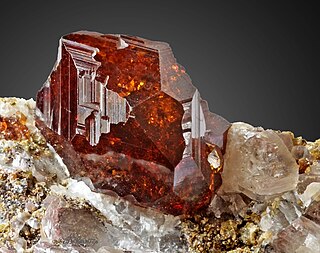
Garnets are a group of silicate minerals that have been used since the Bronze Age as gemstones and abrasives.

Jade is an umbrella term for two different types of decorative rocks used for jewelry or ornaments. Jade is often referred to by either of two different silicate mineral names: nephrite, or jadeite. Nephrite is typically green, although may be yellow, white or black. Jadeite varies from white or near-colorless, through various shades of green, to lavender, yellow, orange, brown and black. Rarely it may be blue. Both of these names refer to their use as gemstones, and each has a mineralogically more specific name. Both the amphibole jade (nephrite) and pyroxene jade are mineral aggregates (rocks) rather than mineral species. Nephrite was deprecated by the International Mineralogical Association as a mineral species name in 1978. The name "nephrite" is mineralogically correct for referring to the rock. Jadeite, is a legitimate mineral species, differing from the pyroxene jade rock. In China, the name jadeite has been replaced with fei cui, the traditional Chinese name for this gem that was in use long before Damour created the name in 1863.

In geology, rock is any naturally occurring solid mass or aggregate of minerals or mineraloid matter. It is categorized by the minerals included, its chemical composition, and the way in which it is formed. Rocks form the Earth's outer solid layer, the crust, and most of its interior, except for the liquid outer core and pockets of magma in the asthenosphere. The study of rocks involves multiple subdisciplines of geology, including petrology and mineralogy. It may be limited to rocks found on Earth, or it may include planetary geology that studies the rocks of other celestial objects.
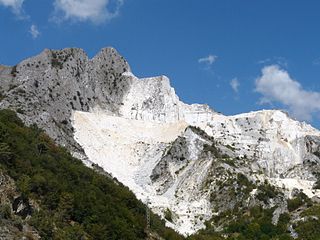
A quarry is a type of open-pit mine in which dimension stone, rock, construction aggregate, riprap, sand, gravel, or slate is excavated from the ground. The operation of quarries is regulated in some jurisdictions to manage their safety risks and reduce their environmental impact.
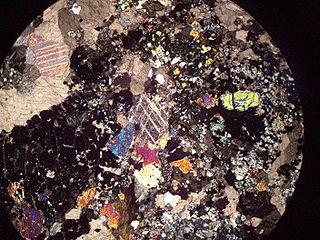
Skarns or tactites are coarse-grained metamorphic rocks that form by replacement of carbonate-bearing rocks during regional or contact metamorphism and metasomatism. Skarns may form by metamorphic recrystallization of impure carbonate protoliths, bimetasomatic reaction of different lithologies, and infiltration metasomatism by magmatic-hydrothermal fluids. Skarns tend to be rich in calcium-magnesium-iron-manganese-aluminium silicate minerals, which are also referred to as calc-silicate minerals. These minerals form as a result of alteration which occurs when hydrothermal fluids interact with a protolith of either igneous or sedimentary origin. In many cases, skarns are associated with the intrusion of a granitic pluton found in and around faults or shear zones that commonly intrude into a carbonate layer composed of either dolomite or limestone. Skarns can form by regional or contact metamorphism and therefore form in relatively high temperature environments. The hydrothermal fluids associated with the metasomatic processes can originate from a variety of sources; magmatic, metamorphic, meteoric, marine, or even a mix of these. The resulting skarn may consist of a variety of different minerals which are highly dependent on both the original composition of the hydrothermal fluid and the original composition of the protolith.

Bluestone is a cultural or commercial name for a number of natural dimension or building stone varieties, including:

The scapolites are a group of rock-forming silicate minerals composed of aluminium, calcium, and sodium silicate with chlorine, carbonate and sulfate. The two endmembers are meionite and marialite. Silvialite (Ca,Na)4Al6Si6O24(SO4,CO3) is also a recognized member of the group.
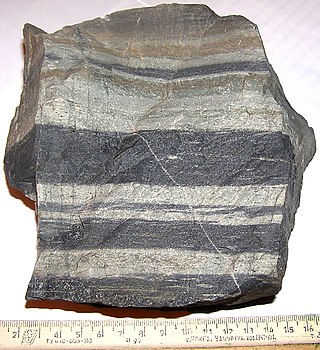
Hornfels is the group name for a set of contact metamorphic rocks that have been baked and hardened by the heat of intrusive igneous masses and have been rendered massive, hard, splintery, and in some cases exceedingly tough and durable. These properties are caused by fine grained non-aligned crystals with platy or prismatic habits, characteristic of metamorphism at high temperature but without accompanying deformation. The term is derived from the German word Hornfels, meaning "hornstone", because of its exceptional toughness and texture both reminiscent of animal horns. These rocks were referred to by miners in northern England as whetstones.

Dimension stone is natural stone or rock that has been selected and finished to specific sizes or shapes. Color, texture and pattern, and surface finish of the stone are also normal requirements. Another important selection criterion is durability: the time measure of the ability of dimension stone to endure and to maintain its essential and distinctive characteristics of strength, resistance to decay, and appearance.

Larimar is the tradename for a rare blue variety of the silicate mineral pectolite found only in Dominican Republic, around the city of Barahona. Its coloration varies from bluish white, light-blue, light-green, green-blue, turquoise blue, turquoise green, turquoise blue-green, deep green, dark green, to deep blue, dark blue and purple, violet and indigo and the larimar can come in many varieties and color mixes.

India possesses a wide spectrum of dimensional stones including granite, marble, sandstone, limestone, slate, and quartzite, found across various parts of the country.

Sand is a granular material composed of finely divided mineral particles. Sand has various compositions but is defined by its grain size. Sand grains are smaller than gravel and coarser than silt. Sand can also refer to a textural class of soil or soil type; i.e., a soil containing more than 85 percent sand-sized particles by mass.
The total cultivable area in India was reported as 155,369,076 hectares as of 2020, and is shrinking due to over-farming, increased livestock grazing, deforestation, urban growth, and severe weather events. India has a total water surface area of 314,070 km2.

The Bass Formation, also known as the Bass Limestone, is a Mesoproterozoic rock formation that outcrops in the eastern Grand Canyon, Coconino County, Arizona. The Bass Formation erodes as either cliffs or stair-stepped cliffs. In the case of the stair-stepped topography, resistant dolomite layers form risers and argillite layers form steep treads. In general, the Bass Formation in the Grand Canyon region and associated strata of the Unkar Group-rocks dip northeast (10°–30°) toward normal faults that dip 60+° toward the southwest. This can be seen at the Palisades fault in the eastern part of the main Unkar Group outcrop area. In addition, thick, prominent, and dark-colored basaltic sills intrude across the Bass Formation.


















